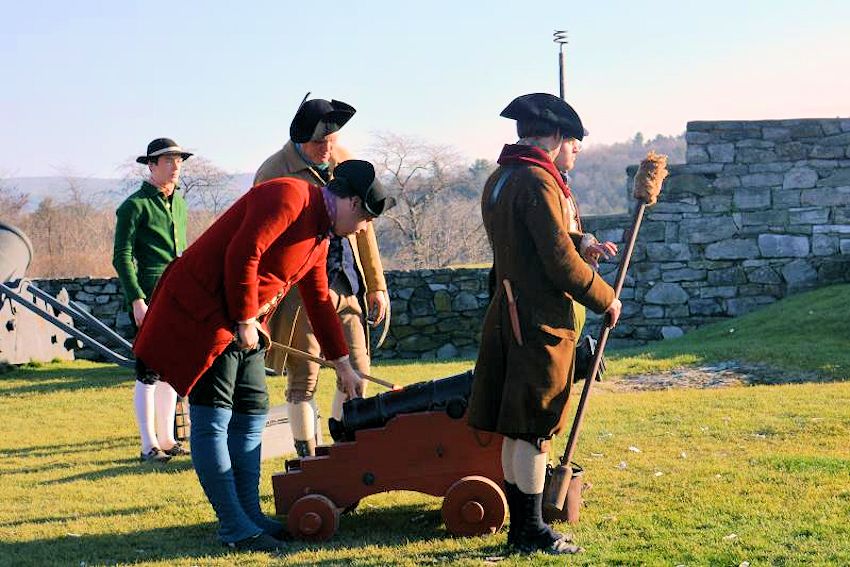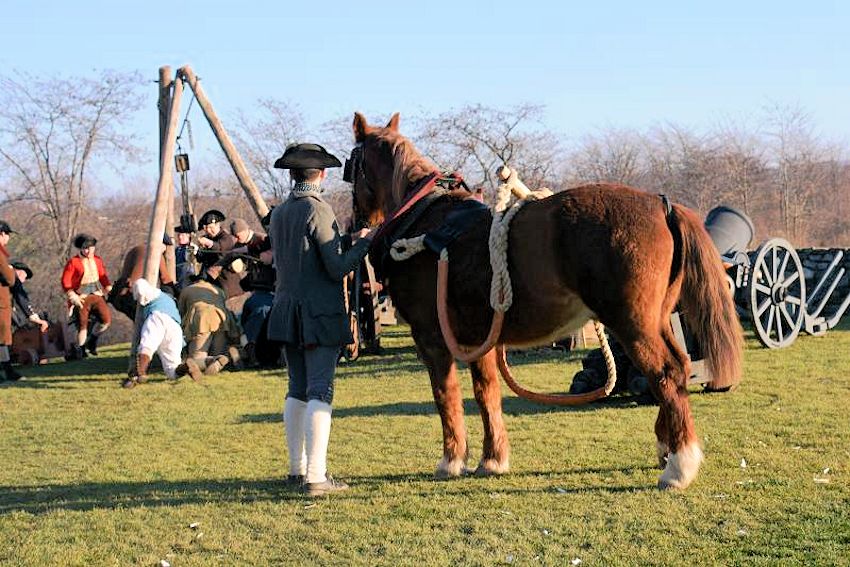2018 Colonel Knox is Now at Ticonderoga
Be there as the Living History Event: Colonel Knox is Now at Ticonderoga (Fort Ticonderoga) on December 7-8, 2018 in Ticonderoga, New York. Discover the epic story of Henry Knox’s “Noble Train” of artillery at Fort Ticonderoga’s upcoming reenactment, from 10 am – 4 pm. The event will feature an exciting program highlighting Henry Knox’s arrival to Fort Ticonderoga and recreate the beginning of the incredible feat that ultimately forced the British evacuation from Boston on March 17, 1776.
Colonel Knox is Now at Ticonderoga
In this one-day “Colonel Knox is Now at Ticonderoga” living history event, step into Fort Ticonderoga as if it were December 6, 1775, when Henry Knox rode into these storied walls. Watch as soldiers, days before their enlistment expires, work as carpenters to maintain the fort. Experience the raw power of oxen as these thousand pound animals pull sleds of cannon tubes. Examine the science of gunnery, preserved in Fort Ticonderoga’s massive cannon collection. Stand inside the stone walls in the stark beauty of winter on the very spot where Henry Knox began his Noble Train of Artillery.
Hours: 9:30 a.m. – 5:00 p.m. Daily
Admission: Event tickets are $10.00; free admission is offered to Members of Fort Ticonderoga, Fort Ticonderoga Ambassador Pass Holders, and children age four and under.
Location
Fort Ticonderoga
102 Fort Ti Road
Ticonderoga, NY 12883
For More Information: Phone: 518-585-2821; Email: info@fort-ticonderoga.org
Colonel Knox is Now at Ticonderoga Mini-Gallery
Step 240 years into the past at Fort Ticonderoga, as if it were December 6, 1775, during this dramatic living history event. Henry Knox rode into Ticonderoga to dispatch thousands of pounds of artillery to General Washington. This event will highlight how Knox’s wealth of knowledge, coupled with the teamsters and draft animals moved 60 tons of ordnance to Cambridge, Massachusetts. Demonstrations utilizing oxen and horses will dramatically feature the logistical challenge Knox faced with moving the heavy artillery while museum interpretive staff will present programs on the science of gunnery including cannon demonstrations.
Visitors will have the opportunity to discover the inspirational story of Henry Knox, the unassuming Boston book seller, whose physical and mental might would be first tested with the ‘noble train’ of artillery. See man power and oxen power in action as fifty-nine cannons and mortars are carefully selected from Fort Ticonderoga. Witness the struggle for liberty and hardships soldiers faced while serving at Ticonderoga in the winter of 1775-1776. Lend a hand to the carpenters repairing Fort Ticonderoga, and learn about the material needs and productions of the new fledging American army and the resources needed for Knox’s epic journey to Boston.”

Knox’s story in many ways represents one of the other great revolutions of the 18th century, the transmission of technical and theoretical knowledge through books. With no military background or education, Knox was able to develop his skills through the world of print that linked together the knowledge of the Western world and beyond.
[su_accordion][su_spoiler title=”Tentative Event Schedule:”]
Living History Event: Colonel Knox is now at Ticonderoga
Saturday & Sunday
10:00 am Fort Ticonderoga Opens to Visitors
10:15 am Key to the Continent Tour (Begins at American Flag)
From Ethan Allen and an invasion of Canadians to the siege of Boston and Henry Knox, see how the events of 1775 fit together. Imagine the first year of the Revolutionary War at this frontier post. Tour through Fort Ticonderoga of today and learn more about the exhibits and demonstrations offered throughout the day.
11:00 am Musket Demonstration (Parade Ground)
From sick Connecticut soldiers ready to go home, to poorly supplied New Yorkers, discover the hardships of soldiers that guarded Ticonderoga in December of 1775. See the array of cobbled-together muskets and fowlers carried by American soldiers in the beginning of the Revolutionary War. Thrill as these soldiers safely work together to load and fire their muskets.
11:30 am Fort Ticonderoga Guided Museum Tour (Parade Ground)
More than a century of collecting has allowed Fort Ticonderoga to acquire North America’s largest and most important collection of 18th -century military material culture. This guided tour will give you the scoop on the most significant, rare, and interesting pieces in the collection.
12:30 pm Tunes of Ticonderoga (Parade Ground)
Hear how drummers and fifers, within an army of former farmers and craftsmen, regulated daily life from reveille in the morning to the tattoo at night. Listen to the stirring tunes of martial music that inspired private soldiers on campaign and influenced the orchestral music of civilian life.
1:15 pm Key to the Continent Tour (Begins at American Flag)
See 10:15 am description.
2:00 pm Cannon Demonstration (Demonstration Area)
How do you know a cannon barrel will not blow up? Learn about the process of proofing, using two to three times a cannon or mortar’s normal charge to test its strength. See how this process was vital for weapons destined for the siege of Boston.
2:30 pm Fort Ticonderoga Guided Museum Tour (Parade Ground)
See 11:30 am description.
3:00 pm Key to the Continent Tour (Begins at American Flag)
See 10:15 am description.
Ongoing 10:00 am-4:00 pm
Tailoring (Officers’ Barracks)
From sewing bed ticks for sleeping, to repairing soldier’s clothes, see how soldiers skilled in sewing provided a necessary service for the new American Army. Discover the stitches and materials applied to this important trade.
Shoemaking (Officers’ Barracks)
Leather shoes wore out quickly during military service. Meet shoemakers among the ranks of soldiers as they repair their comrades’ shoes while on a campaign that tried men’s souls.
Musket Maintenance (Officers’ Barracks)
From newly made American muskets to old refit civilian fowling pieces, see the daily maintenance and repair of the guns to keep them functioning. Learn how oil, brick dust and a little hard work kept a soldier’s gun in serviceable shape.
Soldier’s Dinner (Adjacent to the Demonstration Area)
A good diet kept the young American Army on its feet in 1775. Witness mess cooks turn peas, flour, beef, and other eatables into healthy and delicious stews for their messmates.
Carpentry (Parade Ground)
Watch wood chips fly as carpenters carve away at framing beams to repair that barracks of the fort. See how chisels, saws, and augers helped carpenters rebuild the old fort, even during the harsh winter months.
Exhibit Spaces: Pieces of Eight • Sarah Pell’s Struggle for History and Human Rights • Iron & Stone: Building Fort Carillon • Artillery Court • 1781: A War Not Yet Won • Great Wars: Ticonderoga and World War I • Hands-on Artillery Laboratory.
4:00 pm Fort Ticonderoga Closes to Visitors [/su_spoiler][/su_accordion][su_accordion][su_spoiler title=”Historical Background”]
Historical Background of “Colonel Knox is Now at Ticonderoga”:
The siege of Boston, April 19, 1775 – March 17, 1776 was the opening phase of the American Revolutionary War in which New England militiamen, who later became part of the Continental Army, surrounded the town of Boston, Massachusetts, to prevent movement by the British Army garrisoned within. In November 1775, Washington sent a 25 year-old bookseller-turned-soldier, Henry Knox, to bring heavy artillery that had been captured at Fort Ticonderoga to Boston. Knox knew the challenge before him as he wrote to George Washington on December 5, 1775.
The garrison at Ticonderoga is so weak, the conveyance from the fort to the landing is so difficult, the passage across the lake so precarious, that I am afraid it will be ten days at least before I can get them on this side. When they are here, the conveyance from hence will depend entirely on the sledding; if that is wood, they shall immediately move forward; without sledding, the roads are so much gullied that it will be impossible to move a step.
In a technically complex and demanding operation, Knox began the “Noble Train” in January 1776 at Ticonderoga and carried sixty tons of artillery through the dead of winter to Boston in just forty days. In March 1776, these artillery pieces were used to fortify Dorchester Heights, overlooking Boston and its harbor and threatening the British naval supply lifeline. The British commander William Howe, realizing he could no longer hold the town, chose to evacuate it. He withdrew the British forces, departing on March 17, for Halifax, Nova Scotia thus giving Washington his first great victory of the war.
Fort Ticonderoga is the location of the first Knox Trail marker in the Knox cannon trail that traces the route of the Noble Train. The Fort Ticonderoga Museum owns 2 original artillery pieces that made the epic journey in the winter of 1776.
Mark your calendar today so you don’t miss the next Colonel Knox is Now at Ticonderoga at Fort Ticonderoga in December in Ticonderoga, New York.
Tags: Colonel Knox is Now at Ticonderoga, Henry Knox, Noble Train Begins, Fort Ticonderoga Noble Train, Revolutionary War Reenactment
[/su_spoiler][/su_accordion]


